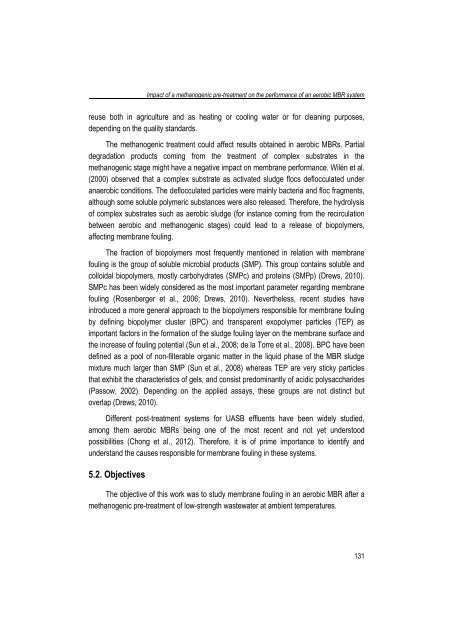Combining submerged membrane technology with anaerobic and ...
Combining submerged membrane technology with anaerobic and ...
Combining submerged membrane technology with anaerobic and ...
You also want an ePaper? Increase the reach of your titles
YUMPU automatically turns print PDFs into web optimized ePapers that Google loves.
Impact of a methanogenic pre-treatment on the performance of an aerobic MBR systemreuse both in agriculture <strong>and</strong> as heating or cooling water or for cleaning purposes,depending on the quality st<strong>and</strong>ards.The methanogenic treatment could affect results obtained in aerobic MBRs. Partialdegradation products coming from the treatment of complex substrates in themethanogenic stage might have a negative impact on <strong>membrane</strong> performance. Wilén et al.(2000) observed that a complex substrate as activated sludge flocs deflocculated under<strong>anaerobic</strong> conditions. The deflocculated particles were mainly bacteria <strong>and</strong> floc fragments,although some soluble polymeric substances were also released. Therefore, the hydrolysisof complex substrates such as aerobic sludge (for instance coming from the recirculationbetween aerobic <strong>and</strong> methanogenic stages) could lead to a release of biopolymers,affecting <strong>membrane</strong> fouling.The fraction of biopolymers most frequently mentioned in relation <strong>with</strong> <strong>membrane</strong>fouling is the group of soluble microbial products (SMP). This group contains soluble <strong>and</strong>colloidal biopolymers, mostly carbohydrates (SMPc) <strong>and</strong> proteins (SMPp) (Drews, 2010).SMPc has been widely considered as the most important parameter regarding <strong>membrane</strong>fouling (Rosenberger et al., 2006; Drews, 2010). Nevertheless, recent studies haveintroduced a more general approach to the biopolymers responsible for <strong>membrane</strong> foulingby defining biopolymer cluster (BPC) <strong>and</strong> transparent exopolymer particles (TEP) asimportant factors in the formation of the sludge fouling layer on the <strong>membrane</strong> surface <strong>and</strong>the increase of fouling potential (Sun et al., 2008; de la Torre et al., 2008). BPC have beendefined as a pool of non-filterable organic matter in the liquid phase of the MBR sludgemixture much larger than SMP (Sun et al., 2008) whereas TEP are very sticky particlesthat exhibit the characteristics of gels, <strong>and</strong> consist predominantly of acidic polysaccharides(Passow, 2002). Depending on the applied assays, these groups are not distinct butoverlap (Drews, 2010).Different post-treatment systems for UASB effluents have been widely studied,among them aerobic MBRs being one of the most recent <strong>and</strong> not yet understoodpossibilities (Chong et al., 2012). Therefore, it is of prime importance to identify <strong>and</strong>underst<strong>and</strong> the causes responsible for <strong>membrane</strong> fouling in these systems.5.2. ObjectivesThe objective of this work was to study <strong>membrane</strong> fouling in an aerobic MBR after amethanogenic pre-treatment of low-strength wastewater at ambient temperatures.131
















